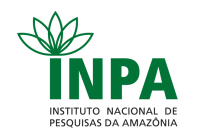Corpo Discente - Egressos
Luciana da Silva Barros
| Título | AVALIAÇÃO DA QUALIDADE DO SOLO DE FLORESTA E ÁREAS ALTERADAS NO ASSENTAMENTO TEPEQUÉM: ATRIBUTOS FÍSICOS, QUÍMICOS E BIOLÓGICOS E A DIVERSIDADE BACTERIANA DO SOLO | ||||||||||||||||||||||||
| Data da Defesa | 30/04/2018 | ||||||||||||||||||||||||
| Download | Em sigilo | ||||||||||||||||||||||||
Banca
| |||||||||||||||||||||||||
| Palavras-Chaves | atividade enzimática, 16S rRNA, desmatamento-queima, pastagem | ||||||||||||||||||||||||
| Resumo | A qualidade dos solos das áreas de floresta do extremo norte da Amazônia é afetada pela mudança de uso do solo. Para compreender esse impacto o objetivou-se avaliar a qualidade do solo de áreas alteradas no Assentamento Tepequém-Roraima. Foram avaliadas uma área floresta nativa (P1), duas áreas de pastagem (P3) e (P2), uma área preparada para plantio convencional de milho (P4), uma área desmatada e queimada (P5) e uma área de plantio de subsistência (P6) em profundidades e períodos distintos. Foram utilizados indicadores químicos, físicos, biológicos, bioquímicos e microbiológicos. Para alcançar o objetivo geral da tese foram desenvolvidos três estudos apresentados em capítulos. No capítulo I, o objetivou-se avaliar a qualidade química por meio do pH em Água, Bases Trocáveis, P disponível, carbono orgânico do solo (COS), nitrogênio, estoque de carbono e a qualidade física por meio dos indicadores de textura e densidade do solo das áreas: A conversão da floresta nativa, o uso e o manejo empregado promoveram mudanças nas características químicas e físicas nas áreas. No capítulo II, o objetivou-se avaliar a influência das práticas do uso da terra nas características biológicas e enzimáticas dos solos. Utilizouse indicadores biológicos e bioquímicos: biomassa microbiana (MBC), respiração basal do solo (RBS), quociente metabólico (qCO2), quociente microbiano (qMIC), enzimas β- glicosidase, fosfatase ácida e urease. A qualidade biológica e enzimática dos solos das áreas P5 e P4 foram influenciadas negativamente pelas práticas de queima, revolvimentos do solo e a ausência da cobertura. O solo da área P3 foi favorecido pela manutenção da cobertura do solo e a ausência do revolvimento. As plantas espontâneas encontradas na área P2 garantiram a diversificação do sistema, proteção e aporte orgânico, influenciando na retomada do equilíbrio ecológico do solo. No capítulo III, por meio de técnicas moleculares de sequenciamento de nova geração Illumina Miseq (Ilumina Inc.), avaliou-se a composição e a diversidade bacteriana. As mudanças nas características químicas e físicas afetaram a riqueza e a diversidade bacteriana das áreas. Os filos Acidobacteria, Proteobacteria, Actinobacteria, Verrucomicrobia e Firmicutes foram os mais abundantes, porém esta abundância variou entre as áreas conforme o uso do solo. | ||||||||||||||||||||||||
| Abstract | The quality of the soils of the forest areas of the extreme north of the Amazon is affected by the change of land use. To understand this impact, the objective was to evaluate the soil quality of altered areas in the Tepequem-Roraima settlement. A native forest area (P1), two pasture areas (P3) and (P2), an area prepared for conventional corn planting (P4), a deforested and burned area (P5) and a subsistence planting area (P6) at different depths and periods. Chemical, physical, biological, biochemical and microbiological indicators were used. In order to achieve the general objective of the thesis, three studies were developed in chapters. In Chapter I, the objective was to evaluate the chemical quality by means of the pH in water, exchangeable bases, available P, soil organic carbon (SOC), nitrogen, carbon stock and the physical quality by means of the indicators of texture and density of the soil of the areas: The conversion of the native forest, the use and management employed promoted changes in the chemical and physical characteristics in the areas. In Chapter II, the objective was to evaluate the influence of land use practices on the biological and enzymatic characteristics of soils. Biological and biochemical indicators: microbial biomass (MBC), basal respiration (SBR), metabolic quotient (qCO2), microbial quotient (qMIC), β-glucosidase enzymes, acid phosphatase and urease were used. The biological and enzymatic quality of the soils of the P5 and P4 areas were negatively influenced by the burning practices, soil disturbances and the absence of the cover. The soil of the P3 area was favored by the maintenance of the soil cover and the absence of the tillage. The spontaneous plants found in the P2 area ensured the diversification of the system, protection and organic contribution, influencing the resumption of the ecological balance of the soil. In Chapter III, by means of molecular techniques of sequencing of new generation Illumina Miseq (Ilumina Inc.), the composition and the bacterial diversity were evaluated. Changes in chemical and physical characteristics affected the richness and bacterial diversity of the areas. The phyla Acidobacteria, Proteobacteria, Actinobacteria, Verrucomicrobia and Firmicutes were the most abundant, but this abundance varied among the areas according to the use of the soil | ||||||||||||||||||||||||
Parceiros

























